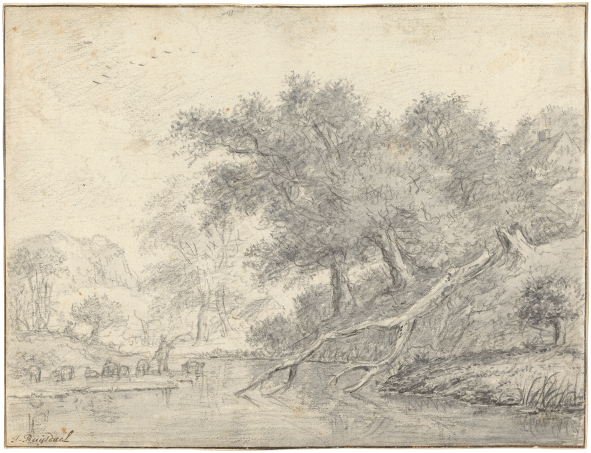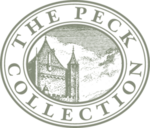Choose a background colour
Jacob van Ruisdael, Dutch, 1628/9-1682: A Group of Trees by the Water, c. 1648-55
Black chalk with silver-gray wash on paper; framing lines in brown ink.
5 3⁄4 × 7 7⁄8 in. (14.6 × 20 cm)
Verso, center right, in black chalk, a drawing with the faint beginnings of a tree branch; lower left, faint traces of former pencil inscription, illegible (erased).
- Chain Lines:
- Vertical, 24 – 26 mm.
- Watermark:
- Fragment of (likely) Foolscap with Five Points, showing a fi gure 4 and three balls. Similar to Ash and Fletcher 1998, 98, 103 (variant F.a.).
- Provenance:
Sale, Christie’s, Amsterdam, 15 November 1993, lot 99; Sheldon and Leena Peck, Boston (Lugt 3847); gift to the Ackland Art Museum, inv. no. 2017.1.73.
- Literature/Exhibitions:
Slive 1995, 455 – 56, fi g. 49; Giltaij 1995, 87 – 88, fi g. 5; Bisanz-Prakken in New York & Fort Worth 1995, 106 (note 4); F. Robinson in Chapel Hill, Ithaca & Worcester 1999 – 2001, 86 – 87, no. 26; Slive 2001, 514 – 15, no. D29.
- Ackland Catalogue:
- 2017.1.73
One of the most celebrated and prolific landscape artists of the seventeenth century, Jacob van Ruisdael completed over 700 paintings and some 150 drawings. He depicted dunes, country roads, townscapes, rivers, canals, and forests, among other quintessential Dutch scenes. Here, a woman and child stand beside a dense grouping of trees beside the water, its smooth reflective surface indicated with touches of gray wash. The sheet belongs to a group of thirty black chalk drawings of similar size that probably belonged to a sketchbook dating from relatively early in the artist’s career. The artist’s lively handling and surety of hand suggest he drew this scene from life.
Jacob van Ruisdael was a landscape painter active in both Haarlem and Amsterdam who remains one of the most celebrated Dutch artists of the seventeenth century. He also had a lasting impact, most notably upon nineteenth-century Romantic landscape painters such as John Constable (1776– 1837).1
While Ruisdael’s enormous painted output totals over 700 works, his corpus of drawings is not nearly so large, standing today at around 150 sheets.2
This number has slowly grown in the past few decades as previously unknown works continue to emerge with some regularity in the marketplace, or occasionally become newly recognized in museum collections. At present, at least fifteen new sheets have emerged since the publication of Seymour Slive’s 2001 oeuvre catalogue, and that many again since Jeroen Giltaij’s first modern catalogue of Ruisdael’s drawings from 1980.3
This present sheet first came to light at auction in 1993, and was mentioned shortly thereafter in separate articles by both Slive and Giltaij as a newly accepted Ruisdael drawing.4
It belongs to a group of around thirty stylistically related black chalk drawings in which the sketch-like appearance and format (most sheets measure around 150 × 200 mm) suggest that they once belonged to a sketchbook.5
Based on their style and relationship to other works, this group can be dated to the late 1640s and early 1650s, and thus relatively early in the artist’s career.6
They give every appearance of having been drawn from life, either in the course of short forays that Ruisdael must have taken into the countryside from his home in Haarlem at the time, or perhaps during the more extensive journey he took to the Westphalian town of Bentheim in Germany around 1650 – 51.7
Three of the drawings from this group relate closely to Ruisdael’s surviving paintings, revealing that he occasionally used this store of motifs back in the studio as the compositional basis for a canvas.8
Most, including the present sheet, appear to have remained unused. Ruisdael signed three sheets in this black chalk sketch group with his monogram, suggesting that he may have sold or given away some of these during his lifetime.9
Slive wrote in admiring terms about this drawing’s “economic touch and all-penetrating atmospheric effect.” 10
Ruisdael’s handling of the chalk displays his lightness and surety of hand, especially in the central group of trees with their twisting trunks and lively foliage. The touches of gray wash in the foliage and along the edge of the water enhance the spatial distinction between foreground and background, though they might be later additions. Several drawings in the black chalk sketch group from these years show trees at the edge of a body of water like this, often with signs of habitation nearby, and staffage like the two figures walking along the path here who appear to be a woman and child. They also frequently contain various degrees of added washes, such as those found in the extensively touched Forest Landscape with a Fallen Tree in Rotterdam Fig. 32.1.11

Jacob van Ruisdael, Forest Landscape with a Fallen Tree, c. 1648 – 55. Black chalk and gray wash on paper, 150 × 195 mm. Rotterdam, Museum Boijmans Van Beuningen, inv. no. JvRuysdael 1.
Collection Museum Boijmans Van Beuningen, Rotterdam. From the estate of F. J. O. Boijmans 1847. Photograph Studio Tromp
The obviously hilly landscape in the Rotterdam sheet suggests its creation during Ruisdael’s trip to Bentheim, and the same might also be true for the Peck drawing (as already suggested by Giltaij), which is stylistically similar and shows a slightly hilly terrain to the right.12
The host of issues related to the questions of who added the washes (if not the artist) to which drawings, and when, has long been a source of conjecture in the scholarly literature, resulting in not infrequent differences of opinion.13
Although at first glance they appear to be later additions, it is entirely possible that Ruisdael added them himself in this case. Their slightly silvery tonality does not correlate well with the type of wash created by diluting the same black chalk as the rest of the drawing, implying, possibly, that these additions were originally in a color or colors that have since faded.14
We know that Ruisdael occasionally applied watercolor to his drawings, more often on his larger and more finished works, but traces of color remain visible on at least three other drawings in this black chalk sketch group.15
End Notes
For overviews of Ruisdael’s life and work, see Slive 2001; and Los Angeles, Philadelphia & London 2005 – 06.
For the basic catalogue of both paintings and drawings (as well as etchings), see Slive 2001.
Giltaij 1980 (listing 113 drawings); Slive 2001 (listing 136 drawings). These two authors continued to add to the corpus in various articles as new drawings emerged, for which see: Slive 1991; Slive 1995; Giltaij 1995; Giltaij 2013; and Giltaij 2020. For a discussion of discrepancies in attribution status of certain drawings between the two authors, see especially Giltaij 2013.
Slive 1995, 455 – 56; and Giltaij 1995, 87 – 88.
Giltaij 1980 (his group 4) initially identified seventeen sheets in this group; expanded in Slive 2001 (not listed together and not always consistently) to around thirty works. See the overviews in Giltaij 1980, 148 – 49; and Slive 2001, 491 – 92. See also Slive 1991 for further considerations of this group. In some cases, it remains difficult to determine whether a drawing truly belongs to this group, due to stylistic factors or having been trimmed.
The date range of circa 1648 – 55 was first established in Giltaij 1980, 148; and reaffirmed in Slive 2001, 491. Neither scholar recorded watermarks in their catalogues of Ruisdael’s drawings, the study of which in the future might prove a means of securing or refining this date range. One of the drawings in this group, formerly in a Swiss private collection, has a later inscription on the verso reading “Jacob Ruisdael 1653,” for which see Slive 1991, 604.
For this trip, see The Hague 2009.
For the three drawings used for paintings, see Slive 2001, nos. D34, D35 (both Bremen, lost in World War II) and D122 (Albertina). Giltaij initially surmised that none of the drawings in this group were used for paintings (Giltaij 1980, 149) but this view was amended in Slive 1991. For Ruisdael’s uses of his drawings for paintings generally, see Slive 1973; Slive 2001, 491 – 92; and Luijten in Washington & Paris 2016 – 17, nos. 98 – 101.
Slive 2001, nos. D74, D100, D134.
Slive 1995, 456; repeated in the entry for the drawing in Slive 2001, no. D29. 11 Slive 2001, no. D111.
Slive 2001, no. D111.
For the initial suggestion, see Giltaij 1995, 88.
Most of these conjectures and various opinions are found in the entries for individual drawings in the catalogues of Giltaij 1980 and Slive 2001; but see also Broos 1989.
Conservator Grace White examined the drawing under a microscope and did not find traces of pigment particles, though it is possible that Ruisdael used a dye instead. My thanks to her and to Reba Snyder (Thaw Conservation Center, Morgan Library & Museum) for their discussions around this issue.
Slive 2001, nos. D16, D20, D65, D134 (the latter also bearing Ruisdael’s autograph monogram). See Slive 2001, 491, for a list of drawings embellished with watercolor.
